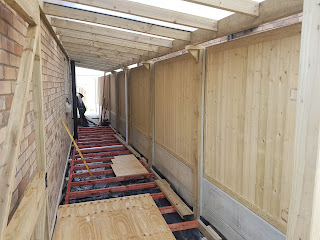A constructing a lean-to shed can be a fulfilling and practical project that provides valuable storage space for your outdoor belongings. The roof and walls are crucial components of the shed that require careful consideration and proper construction techniques to ensure durability, stability, and protection from the elements. In this article, we will guide you through the steps to build the roof and walls of a lean-to shed, using active voice and a friendly tone, to help you create a functional and attractive outdoor structure that meets your specific needs.
Step 1: Roof Framing
The roof is a critical part of your lean-to shed as it provides shelter and protects the contents of the shed from rain, snow, and other environmental elements. Follow these steps to frame the roof:
- Measure and cut the rafters: Determine the length and slope of your roof and use these measurements to cut the rafters from green lumber. Rafters are the diagonal members that support the roof and give it its pitch. Make sure to cut them accurately and to the proper length.
- Mark the top plate: On the top plate of the shed's walls, mark the locations where the rafters will be attached. Use a framing square to ensure the markings are square and level.
- Attach the rafters: Nail or screw the rafters to the top plate, making sure they are aligned with the markings and spaced evenly. Use a level to check for plumb and adjust as needed.
- Install ridge beam or ridge board: Depending on your design, you may need to install a ridge beam or a ridge board to provide additional support to the rafters at the peak of the roof. Secure it in place with nails or screws.
- Add roof sheathing: Once the rafters and ridge are in place, you can install the roof sheathing, which is the plywood or OSB (oriented strand board) that covers the roof framing. Nail or screw the sheathing to the rafters, leaving appropriate gaps for ventilation as per local building codes.
- Install drip edge and roofing material: To protect the roof from water damage, install a drip edge along the eaves and rake edges of the roof. Then, apply the roofing material of your choice, such as shingles or metal sheets, following the manufacturer's instructions.
Step 2: Wall Framing
The walls of your lean-to shed provide structural support and enclosure for the contents of the shed. Follow these steps to frame the walls:
- Measure and cut the wall studs: Measure and cut the wall studs from green lumber, according to your shed's design and dimensions. Make sure to cut them accurately and to the proper length.
- Mark the wall plate: On the bottom plate of the shed's walls, mark the locations where the wall studs will be attached. Use a framing square to ensure the markings are square and level.
- Attach the wall studs: Nail or screw the wall studs to the bottom plate, making sure they are aligned with the markings and spaced evenly. Use a level to check for plumb and adjust as needed.
- Add additional framing members: Depending on your design, you may need to add additional framing members, such as headers, cripple studs, and corner studs, to provide structural support and reinforcement for openings such as doors and windows.
- Install door and window frames: If your lean-to shed includes doors and windows, install the door and window frames according to the manufacturer's instructions. Make sure they are plumb, level, and square to ensure proper operation and fit.
- Attach wall sheathing: Once the wall framing is complete, you can attach the wall sheathing, which is typically made of plywood or OSB. Nail or screw the sheathing to the wall studs, leaving appropriate gaps for ventilation as per local building codes.
- Install siding: After the sheathing is in place, you can install the siding of your choice, such as wood, vinyl, or metal. Follow the manufacturer's instructions for proper installation, including any required weatherproofing measures.
- Add trim and finishing touches: To give your lean-to shed a polished look, add trim and finishing touches, such as corner boards, fascia, soffit, and any other decorative elements you desire. Sand, paint, or stain the exterior of the shed to protect it from the elements and enhance its appearance.
Conclusion
Building a lean-to shed with green lumber requires careful planning and precise construction techniques to ensure a sturdy and durable structure. By following the steps outlined in this article, you can successfully frame the roof and walls of your lean-to shed, creating a functional and attractive outdoor storage space that meets your specific needs. Remember to always comply with local building codes and regulations, and seek professional assistance if you are not confident in your woodworking skills. With proper care and maintenance, your DIY lean-to shed will provide years of reliable service.

0 comments:
Post a Comment
Note: Only a member of this blog may post a comment.